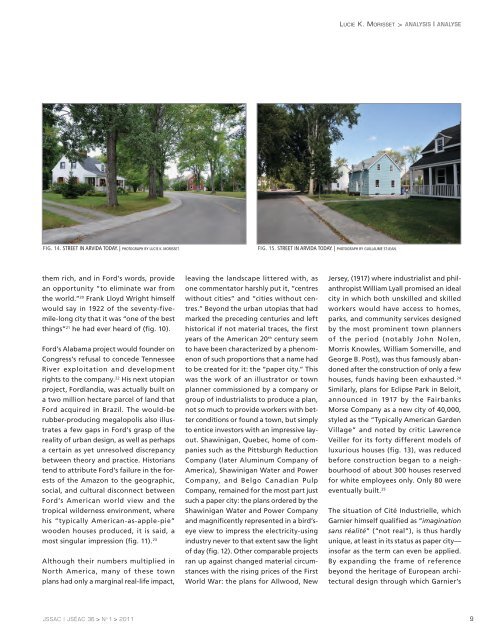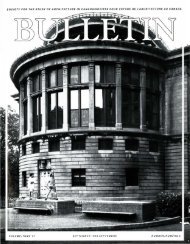'à es us e ct n s, es - Sexton Digtial Initiatives - Dalhousie University
'à es us e ct n s, es - Sexton Digtial Initiatives - Dalhousie University
'à es us e ct n s, es - Sexton Digtial Initiatives - Dalhousie University
Create successful ePaper yourself
Turn your PDF publications into a flip-book with our unique Google optimized e-Paper software.
fig. 14. street in ArvidA tOdAy. | PhOtOgrAPh by lucie k. mOrisset. fig. 15. street in ArvidA tOdAy. | PhOtOgrAPh by guillAume st-JeAn.<br />
them rich, and in Ford’s words, provide<br />
an opportunity “to eliminate war from<br />
the world.” 20 Frank Lloyd Wright himself<br />
would say in 1922 of the seventy-fivemile-long<br />
city that it was “one of the b<strong>es</strong>t<br />
things” 21 he had ever heard of (fig. 10).<br />
Ford’s Alabama proje<strong>ct</strong> would founder on<br />
Congr<strong>es</strong>s’s ref<strong>us</strong>al to concede Tenn<strong>es</strong>see<br />
River exploitation and development<br />
rights to the company. 22 His next utopian<br />
proje<strong>ct</strong>, Fordlandia, was a<strong>ct</strong>ually built on<br />
a two million he<strong>ct</strong>are parcel of land that<br />
Ford acquired in Brazil. The would-be<br />
rubber-producing megalopolis also ill<strong>us</strong>trat<strong>es</strong><br />
a few gaps in Ford’s grasp of the<br />
reality of urban d<strong>es</strong>ign, as well as perhaps<br />
a certain as yet unr<strong>es</strong>olved discrepancy<br />
between theory and pra<strong>ct</strong>ice. Historians<br />
tend to attribute Ford’s failure in the for<strong>es</strong>ts<br />
of the Amazon to the geographic,<br />
social, and cultural disconne<strong>ct</strong> between<br />
Ford’s American world view and the<br />
tropical wildern<strong>es</strong>s environment, where<br />
his “typically American-as-apple-pie”<br />
wooden ho<strong>us</strong><strong>es</strong> produced, it is said, a<br />
most singular impr<strong>es</strong>sion (fig. 11). 23<br />
Although their numbers multiplied in<br />
North America, many of th<strong>es</strong>e town<br />
plans had only a marginal real-life impa<strong>ct</strong>,<br />
JSSAC | JSÉAC 36 > N o 1 > 2011<br />
leaving the landscape littered with, as<br />
one commentator harshly put it, “centr<strong>es</strong><br />
without citi<strong>es</strong>” and “citi<strong>es</strong> without centr<strong>es</strong>.”<br />
Beyond the urban utopias that had<br />
marked the preceding centuri<strong>es</strong> and left<br />
historical if not material trac<strong>es</strong>, the first<br />
years of the American 20th century seem<br />
to have been chara<strong>ct</strong>erized by a phenomenon<br />
of such proportions that a name had<br />
to be created for it: the “paper city.” This<br />
was the work of an ill<strong>us</strong>trator or town<br />
planner commissioned by a company or<br />
group of ind<strong>us</strong>trialists to produce a plan,<br />
not so much to provide workers with better<br />
conditions or found a town, but simply<br />
to entice inv<strong>es</strong>tors with an impr<strong>es</strong>sive layout.<br />
Shawinigan, Quebec, home of compani<strong>es</strong><br />
such as the Pittsburgh Redu<strong>ct</strong>ion<br />
Company (later Aluminum Company of<br />
America), Shawinigan Water and Power<br />
Company, and Belgo Canadian Pulp<br />
Company, remained for the most part j<strong>us</strong>t<br />
such a paper city: the plans ordered by the<br />
Shawinigan Water and Power Company<br />
and magnificently repr<strong>es</strong>ented in a bird’seye<br />
view to impr<strong>es</strong>s the ele<strong>ct</strong>ricity-<strong>us</strong>ing<br />
ind<strong>us</strong>try never to that extent saw the light<br />
of day (fig. 12). Other comparable proje<strong>ct</strong>s<br />
ran up against changed material circumstanc<strong>es</strong><br />
with the rising pric<strong>es</strong> of the First<br />
World War: the plans for Allwood, New<br />
Lucie K. Morisset > aNalysis | aNalyse<br />
Jersey, (1917) where ind<strong>us</strong>trialist and philanthropist<br />
William Lyall promised an ideal<br />
city in which both unskilled and skilled<br />
workers would have acc<strong>es</strong>s to hom<strong>es</strong>,<br />
parks, and community servic<strong>es</strong> d<strong>es</strong>igned<br />
by the most prominent town planners<br />
of the period (notably John Nolen,<br />
Morris Knowl<strong>es</strong>, William Somerville, and<br />
George B. Post), was th<strong>us</strong> famo<strong>us</strong>ly abandoned<br />
after the constru<strong>ct</strong>ion of only a few<br />
ho<strong>us</strong><strong>es</strong>, funds having been exha<strong>us</strong>ted. 24<br />
Similarly, plans for Eclipse Park in Beloit,<br />
announced in 1917 by the Fairbanks<br />
Morse Company as a new city of 40,000,<br />
styled as the “Typically American Garden<br />
Village” and noted by critic Lawrence<br />
Veiller for its forty different models of<br />
luxurio<strong>us</strong> ho<strong>us</strong><strong>es</strong> (fig. 13), was reduced<br />
before constru<strong>ct</strong>ion began to a neighbourhood<br />
of about 300 ho<strong>us</strong><strong>es</strong> r<strong>es</strong>erved<br />
for white employe<strong>es</strong> only. Only 80 were<br />
eventually built. 25<br />
The situation of Cité Ind<strong>us</strong>trielle, which<br />
Garnier himself qualified as “imagination<br />
sans réalité” (“not real”), is th<strong>us</strong> hardly<br />
unique, at least in its stat<strong>us</strong> as paper city—<br />
insofar as the term can even be applied.<br />
By expanding the frame of reference<br />
beyond the heritage of European archite<strong>ct</strong>ural<br />
d<strong>es</strong>ign through which Garnier’s<br />
9

















